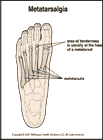
Metatarsalgia
What is metatarsalgia?
The metatarsal bones are the long bones of the feet. They are located between the bones that form the ankle (tarsal bones) and the bones of the toes (phalanges). Metatarsalgia is pain in the long bones of the feet, especially located at the heads, or tips, of these bones.
How does it occur?
Metatarsalgia typically occurs from doing too much of a weight-bearing activity such as running, jumping, or walking. It may occur if you start wearing a new type of shoes, especially high-heeled shoes. In some people, the tips of some metatarsals point further down than in others, making these bones more likely to hurt.
What are the symptoms?
You have pain in the middle of the foot, especially over the bones. You have pain when the bones move and tenderness over the bony surfaces.
How is it diagnosed?
Your health care provider will examine your foot and may order an x-ray to see if a foot bone is fractured. If you have metatarsalgia, the x-ray will show no break.
How is it treated?
You may be treated with an anti-inflammatory medication. Your health care provider may prescribe a pad to put underneath the tender metatarsal. Custom-made arch supports (orthotics) are often prescribed for metatarsalgia.
While you are recovering from your injury, you will need to change your sport or activity to one that does not make your condition worse. For example, you may need to swim or bicycle instead of run or walk.
When can I return to my sport or activity?
The goal of rehabilitation is to return you to your sport or activity as soon as is safely possible. If you return too soon you may worsen your injury, which could lead to permanent damage. Everyone recovers from injury at a different rate. Return to your sport or activity will be determined by how soon your foot recovers, not by how many days or weeks it has been since your injury occurred. In general, the longer you have symptoms before you start treatment, the longer it will take to get better.
You may safely return to your sport or activity when, starting from the top of the list and progressing to the end, each of the following is true:
- You have full range of motion in the injured foot compared to the uninjured foot.
- You have full strength of the injured foot compared to the uninjured foot.
- You can jog straight ahead without pain or limping.
- You can sprint straight ahead without pain or limping.
- You can do 45-degree cuts, first at half-speed, then at full-speed.
- You can do 20-yard figures-of-eight, first at half-speed, then at full-speed.
- You can do 90-degree cuts, first at half-speed, then at full-speed.
- You can do 10-yard figures-of-eight, first at half-speed, then at full-speed.
- You can jump on both feet without pain and you can jump on the injured foot without pain.
How can I prevent metatarsalgia?
Metatarsalgia is best prevented by wearing good shoes that fit well.

